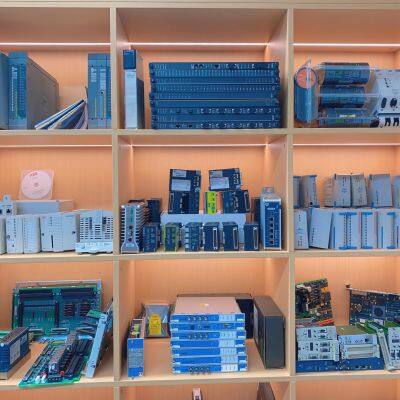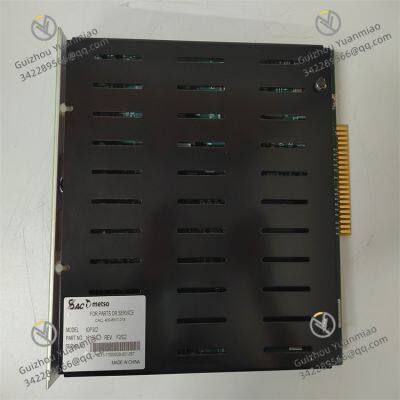Product Description
I. Overview
METSO IOP302 is a high-performance analog input module. It is mainly responsible for receiving and accurately processing analog input signals from various sensors, which cover continuously changing physical quantities such as temperature, pressure, and flow. After converting these signals into digital signals, it provides them to the control system for subsequent calculations and decision-making. It is a key link in realizing precise control and monitoring in industrial automated production processes.

II. Technical Parameters
Power Supply Specifications: The input voltage is 24V DC. This common and stable DC voltage input can adapt to most industrial power supply environments, ensuring stable operation of the equipment. At the same time, it has good power utilization efficiency, reducing energy consumption.
Input Characteristics: It supports 4-20mA current signal or 0-10V voltage signal input, which can meet the output requirements of different types of sensors. The resolution can reach 12 bits or even higher; for example, some models can reach 16-bit resolution, ensuring that subtle changes in analog signals can be accurately captured, achieving high-precision measurement, and providing a solid foundation for industrial applications with strict requirements on process parameters.
Number of Channels: It is usually equipped with multiple input channels, with common configurations of 8 channels or 16 channels. It can connect multiple sensors or devices at the same time, realizing synchronous acquisition and processing of multiple groups of analog signals, which greatly improves the efficiency and comprehensiveness of data acquisition. It is suitable for the real-time monitoring needs of multiple parameters in complex industrial scenarios.
Communication Interfaces: It is equipped with multiple communication interfaces. The Ethernet interface is used for high-speed and long-distance data transmission, facilitating large amounts of data interaction with upper computers or other intelligent devices; the serial port (such as RS-485) has good anti-interference ability and can stably transmit data in the complex electromagnetic environment of industrial sites. In terms of communication protocols, it supports common industrial communication protocols such as Modbus TCP/IP and Modbus RTU, ensuring seamless connection with various control systems, PLCs (Programmable Logic Controllers), or data acquisition systems, and realizing smooth sharing and exchange of data.
Physical Characteristics: It has a compact size design, which is convenient for installation in positions with limited space such as control cabinets without occupying too much space. The operating temperature range is -40°C to 85°C, which can adapt to various extreme temperature conditions such as high-temperature industrial production workshops and cold outdoor working environments. It has a certain level of protection, with dustproof and moisture-proof capabilities, and can operate stably in harsh industrial environments with much dust and humidity, ensuring long-term reliability of the equipment.

III. Functional Features
High-Precision Signal Conversion: It adopts advanced analog-to-digital conversion technology internally, which can accurately convert the input analog signals into digital signals with minimal conversion errors. In industrial production, for scenarios where the temperature control accuracy is required to reach ±0.1°C, or processes where the pressure measurement accuracy is required to be as precise as 0.01MPa, IOP302 can rely on its high-precision conversion function to ensure that the control system obtains accurate data, thereby achieving precise control and ensuring the stability and consistency of product quality.
Flexible Configuration Options: It supports flexible configuration through software. Users can freely adjust the input range according to actual application needs, such as adjusting the voltage input range from the default 0-10V to -5V to +5V; the resolution can also be set according to signal characteristics and accuracy requirements. In occasions that require fast response but relatively low accuracy requirements, the resolution can be appropriately reduced to improve the sampling speed; while at key measurement points with extremely high accuracy requirements, high resolution is set to obtain more accurate data; the sampling rate can also be adjusted as needed, ranging from several times per second to thousands of times per second, meeting the diverse needs of different industrial processes for data acquisition frequency.
Reliable Isolation Design: It adopts an isolation design to effectively isolate the analog signals input by on-site sensors from the control system. This isolation can greatly suppress electromagnetic interference generated by the complex electromagnetic environment of industrial sites, prevent interference signals from entering the control system and causing data errors or equipment failures, improve the reliability and stability of the entire system, and ensure stable operation and accurate signal acquisition even in environments with strong electromagnetic interference, such as workshops where large motors start and stop frequently.
Advantages of Modular Design: It adopts a modular structure, with each functional module being relatively independent. On the one hand, it is convenient for installation and maintenance. During installation, it can be flexibly arranged according to the system architecture to quickly complete the installation; when a fault occurs, it is easy to troubleshoot and locate. If a channel module has a problem, it can be directly replaced individually without large-scale maintenance of the entire equipment, effectively shortening the maintenance time and reducing maintenance costs. On the other hand, it provides convenience for system expansion. As the production scale of enterprises expands or processes improve, when it is necessary to increase the number of analog input points, IOP302 modules or related expansion modules can be easily added to improve the input capacity of the system and meet the development needs of enterprises.

IV. Operation and Maintenance Guide
Installation Process
Before installation, be sure to turn off the power of all related equipment and wear an anti-static wristband to prevent static electricity from damaging the precision electronic components inside IOP302.
Carefully check the appearance of the module to see if there are any abnormalities such as damage, deformation, or falling components. If there is a problem, contact the supplier for replacement immediately and do not force installation.
According to the equipment installation manual, align the IOP302 smoothly with the target slot or mounting bracket in the control cabinet, insert it slowly and accurately to ensure that the interface is fully engaged and connected firmly, avoiding damage to the interface pins due to improper insertion.
Use the matching screws or fixing devices to firmly fix the module in the installation position to prevent the module from loosening due to vibration or external forces during equipment operation, which may affect signal transmission and the normal operation of the equipment.
After installation, check the firmness of the module installation and the interface connection status again. Only after confirmation can the power of the equipment be turned on.
Parameter Configuration
Connect the IOP302 to the configuration equipment (such as an engineer station, upper computer) through a suitable communication cable (such as an Ethernet cable or RS-485 communication cable) to ensure that the communication line is connected normally without looseness, disconnection, or other problems.
Start the corresponding configuration software, which usually automatically identifies the connected IOP302 device. If it is not automatically identified, carefully check the communication settings (such as IP address, baud rate, communication protocol, etc.) and device connection status, and add the device manually.
In the configuration software interface, set the various parameters of IOP302 in detail according to the actual industrial application scenarios and control requirements. This includes defining the type of input channel (current input or voltage input), setting the input range, adjusting key parameters such as resolution and sampling rate. During the setting process, be sure to strictly follow the equipment technical manual and actual production process requirements to ensure that the parameter settings are accurate and error-free, avoiding abnormal data acquisition or equipment failure caused by incorrect parameters.
After completing the parameter settings, save the settings and conduct a comprehensive verification of the setting results. You can input standard 4-20mA current signals or 0-10V voltage signals through a signal generator to observe whether the output response of IOP302 meets expectations and whether the data display is accurate; or conduct simple functional tests to check whether the equipment can work normally according to the set parameters and logic. If there is a deviation, return to the parameter setting interface in time for careful adjustment until the equipment operates normally.


METSO IOP351 Relay Output Module
Allen-Bradley 1746-A4 Expansion Module
Allen-Bradley 1746-A7 Expansion Module
Allen-Bradley 1746-BAS SLC 500 SLC BASIC Module
Allen-Bradley 1746-HS Motion Control Module
Allen-Bradley 1746-HSCE SLC 500 High-Speed Counter Module
Allen-Bradley 1746-IB16 Original Packaging Module
Allen-Bradley 1746-IB32 Digital DC Input Module
Allen-Bradley 1746-IM16 Digital AC Input Module
Allen-Bradley 1746-IN16 Sinking Input Module
Allen-Bradley 1746-ITB16 PLC I/O Module
Allen-Bradley 1746-IV16 Digital Input Module
Allen-Bradley 1746-NI4 Analog I/O Module
Allen-Bradley 1746-NI16I Analog I/O Module
Allen-Bradley 1746-NIO4I Analog Combination Module
Allen-Bradley 1746-NO4V Standard Analog Voltage Output Module.
Allen-Bradley 1746-NT8 Thermocouple/mV Analog Input Module
Allen-Bradley 1746-OA16 Digital AC Output Module
 yezi
Hi there! Welcome to my shop. Let me know if you have any questions.
yezi
Hi there! Welcome to my shop. Let me know if you have any questions.





